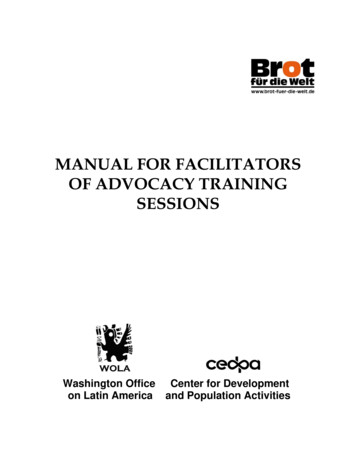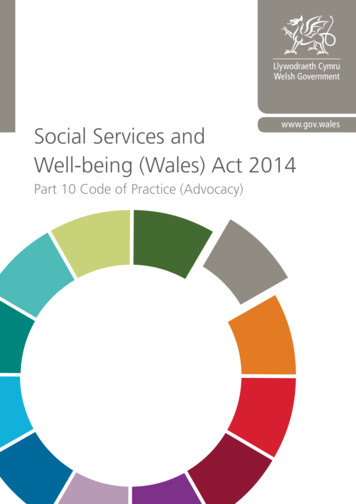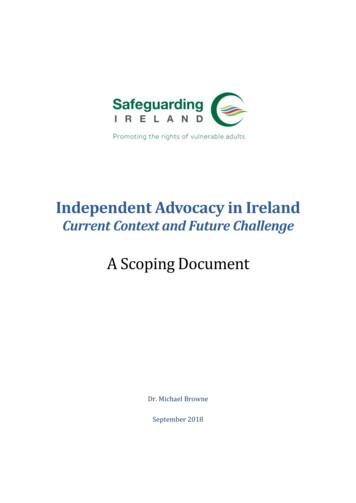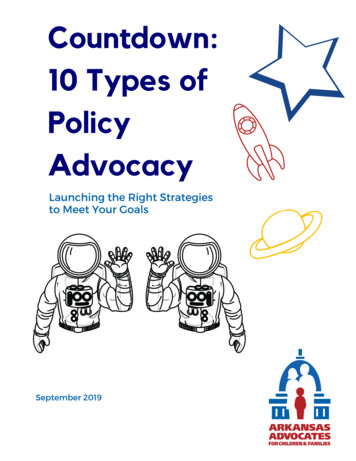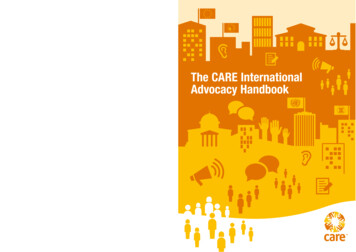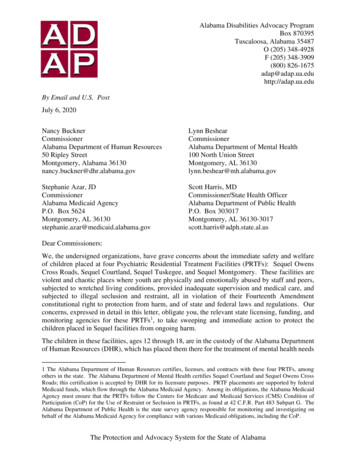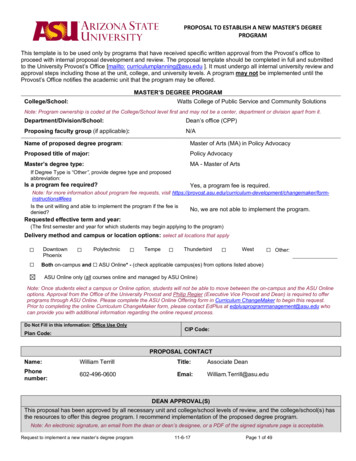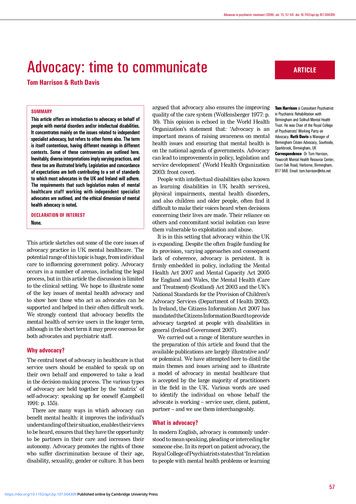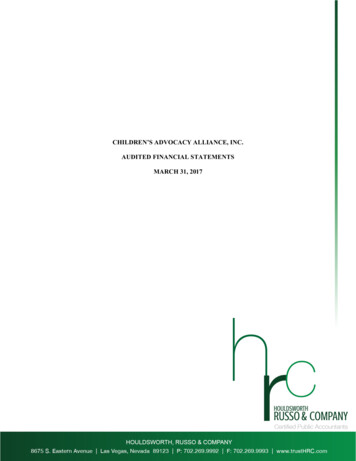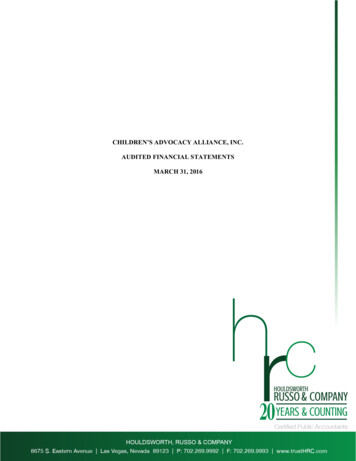
Transcription
View metadata, citation and similar papers at core.ac.ukbrought to you byCOREprovided by Digital Commons @ Butler UniversityButler UniversityDigital Commons @ Butler UniversityUndergraduate Honors Thesis CollectionUndergraduate Scholarship4-23-2011Service, Education, and Advocacy within a StudentRun Pharmacy: An Evaluation of the ButlerUniversity Community Outreach PharmacyEliza Anne DyButler UniversityFollow this and additional works at: http://digitalcommons.butler.edu/ugthesesPart of the Other Pharmacy and Pharmaceutical Sciences CommonsRecommended CitationDy, Eliza Anne, "Service, Education, and Advocacy within a Student-Run Pharmacy: An Evaluation of the Butler UniversityCommunity Outreach Pharmacy" (2011). Undergraduate Honors Thesis Collection. Paper 93.This Thesis is brought to you for free and open access by the Undergraduate Scholarship at Digital Commons @ Butler University. It has been acceptedfor inclusion in Undergraduate Honors Thesis Collection by an authorized administrator of Digital Commons @ Butler University. For moreinformation, please contact fgaede@butler.edu.
Service, Education, and Advocacy within a Student-Run Pharmacy:An Evaluation of the Butler University Community Outreach PharmacyA ThesisPresented to the College of Pharmacy and Health Sciencesandthe Honors ProgramofButler UniversityIn Partial Fulfillmentof the Requirements for Graduation HonorsEliza Anne DyPharmD Candidate, Butler UniversityFounding Committee Chair, Butler University Community Outreach PharmacyApril 23, 2011
TABLE OF CONTENTSStatement of P Mission Statement3Hypothesis4Objectives4Methods5Service Survey Procedures5Education Survey Procedures6Advocacy Survey Procedures7Statistical Analysis8Results8Service Survey Results8Education Survey Results10Advocacy Survey Results11Discussion12Conclusion15i
Acknowledgments16References18Appendices19Appendix A19Appendix B21Appendix C24Tables26Table 126Table 227Table 328Table 429Table 530Table 631ii
STATEMENT OF CONTRIBUTIONSThis thesis project was conducted in partnership with Tyler D. Trueg, PharmD Candidate, MBACandidate.a,b Work on this project was also completed under the mentorship of Kristal L. Williams,PharmD.c,d,e Outlined below are the specific contributions which I made to this study.For the inception of this project, I designed the service and advocacy study portions of the project. Iauthored the corresponding service and advocacy survey and served as the editor of educationsurvey. I also co-authored the study protocol and Institutional Review Board application.In the implementation phase of the study, I served as a primary investigator and administered halfof the surveys on the randomly selected data collection days.For the final report of the study, I independently authored the Introduction, Hypothesis, Discussion,Conclusions, and Acknowledgments sections. I also co-authored the Abstract, Objectives, andMethods sections, and edited and reviewed Results and Tables sections.aButler University College of Pharmacy and Health Sciences, Indianapolis, INbFounding Vice-Chair, Butler University Community Outreach Pharmacy, Indianapolis, INcIndiana University Health – Methodist/IU Family Practice Center, Indianapolis, INdAssistant Professor of Pharmacy Practice and Advisor, Butler University College of Pharmacy andHealth Sciences, Indianapolis, INeAdvisor, Butler University Community Outreach Pharmacy, Indianapolis, INiii
ABSTRACTObjectiveTo investigate three domains of the student-run Butler University Community Outreach Pharmacy’s(BUCOP) mission statement.MethodsThis multi-phase, survey-based study evaluated the execution of BUCOP’s mission statement in theareas of service, education, and advocacy.ResultsThe service survey found that the majority ( 78%) of patients were satisfied with most aspects ofBUCOP’s care; however, patients were most displeased with hours of operation and wait time. Theeducation survey results demonstrated BUCOP’s role as an early confidence-building experience;however, noteworthy clinical interactions with medical students were limited. The advocacy surveyrevealed that 96% of community members interviewed were unaware of BUCOP; however, theyreported comfort with students providing prescriptions and counseling.ConclusionBUCOP is satisfactorily fulfilling its mission statement in terms of service and education, butimprovements can be made to better impact patients and students. In the area of advocacy,particularly community awareness of BUCOP’s free healthcare services, the mission is not beingfulfilled.1
INTRODUCTIONHistoryWithin the Eastside Indianapolis, IN community, 50% of the population lives at or below povertylevel.1 For this particular community, like many others across the United States, access to affordablehealth care poses a major problem. In an attempt to assist such populations, federally fundedhealth care systems were established as part of the War on Poverty. 2 In response to the War onPoverty initiative, Citizens Health Center became the first federally funded clinic in Indianapolis. 2Additionally, for over 150 years, Wishard Health Services has provided care for underserved patientsat its main hospital campus and at 8 additional satellite clinics throughout the city. 3 Further effortsto assist the Indianapolis underserved included the establishment of several free clinics, such as theGenneseret Free Clinic and Shepherd Community Center.In 2010, President Obama signed the Patient Protection and Affordable Care Act and the Healthcareand Education Reconciliation Act of 2010 with a vision and goal to dramatically reform health careand to allow individuals to obtain affordable health care coverage over the next several years.4,5Additionally, in recent years, several student-run, free clinics have been established. Reportedly,there are 60 student-run free clinics in the United States; at the time this thesis was submitted, theButler University Community Outreach Pharmacy (BUCOP), in conjunction with the IndianaUniversity Student Outreach Clinic (IUSOC), was the only student-run free healthcare provider in thestate of Indiana.6On August 1st, 2009, BUCOP opened as a free, student-run pharmacy.7 The services providedincluded, (1) free medications, (2) non-drug therapies, (3) medication counseling and (4) druginformation, such as initial doses, indications, and monitoring parameters to student-physicians of2
the partnering IUSOC. The IUSOC and BUCOP operate out of the Neighborhood Fellowship Churchon Saturdays from 10:00 am – 2:00 pm.7Furthermore, the service-learning and public health components of the student-run pharmacyreflect the academic public health and interdisciplinary education initiatives of the AccreditationCouncil for Pharmacy Education (ACPE). According to the 2011 ACPE Accreditation Standards andGuidelines for the Professional Program in Pharmacy Leading to the Doctor of Pharmacy Degree, apre-advanced pharmacy practice experience core domain is Health and Wellness – Public Health.8 Itstates that students should, “Know and apply principles of health and wellness in provision ofindividual and population-based health and wellness information” and “Integrate uniquecharacteristics of individuals and populations in design of health and wellness information.” 8Additionally, in accordance with the American Association of Colleges of Pharmacy (AACP) Centerfor Advancement of Pharmaceutical Education (CAPE) 2004 Educational Outcomes, the ACPEAccreditation Standards recommend that students fulfill their public health and other educationexperiences, such as experiential experiences “in cooperation with other members of aninterprofessional team of health care providers.” 8BUCOP Mission StatementSERVICE: To provide medically underserved and uninsured populations within Indianapoliswith access to basic medication for acute disease states, information on non-drugtherapies, and education on chronic disease prevention at no cost to the patientEDUCATION: To provide pre-professional and professional COPHS students with theopportunity to expand clinical skills, explore aspects of clinic administration, build interdisciplinary skills with other Indiana professional students, and better understandcommunity resources available to uninsured patients3
UNDERSTANDING: To provide a setting in which medical research regarding social,cultural, and financial influences on the delivery of healthcare to underserved anduninsured populations can be conductedADVOCACY: To advocate for universal access to adequate and affordable healthcare andmedications for the underserved and uninsured populations of IndianapolisHYPOTHESISBUCOP is fulfilling its mission by (1) providing pharmaceutical care through medications andcounseling (Service), (2) educating students in a unique setting outside of the classroom (Education),and (3) providing an opportunity for service learning (Education); however, it is hypothesized thatthe mission of advocacy has yet to be fully explored and pursued within the local Indianapoliscommunity (Advocacy).Although not a direct measure of the project, it is additionally hypothesized that the successfulcompletion of this project will stimulate future research on underserved health care providers suchas BUCOP (thus fulfilling Understanding).OBJECTIVESThe goal of this study was to objectively evaluate three primary domains of the BUCOP missionstatement in order to assess progress, expose weaknesses, and identify areas of improvement. Themission domains evaluated for quality improvement were service, education, and advocacy. Thespecific objectives for each domain are listed below.Service. To evaluate the quality of service and pharmaceutical care products (defined as medicationdispensing and medication counseling) rendered by BUCOP.4
Education. To evaluate the effectiveness of the BUCOP training program and the benefit of thisunique service-learning experience, specifically its value-added pharmaceutical care andmanagement opportunities to the existing pharmacy curriculum.Advocacy. To assess the barriers which exist in providing care to the surrounding community, suchas amount of publicity and community perceptions of a student-run pharmacy.METHODSThis study was approved by the Indiana University Health Institutional Review Board in accordancewith the principles outlined in the Declaration of Helsinki. 9 All subjects provided informed consent,which, given the design of the study, was implied with completion of the survey.Unique surveys were created, by the investigators, for each of the three study domains. All datacollection and survey participant recruitment were conducted by the primary investigators.All surveys were conducted in adult individuals, which was defined as 18 years of age or older. Atthe time of the study invitation, participants were educated on the study design, purpose, timecommitment, and voluntary nature of the study. Additionally, the investigators emphasized thatthere was no penalty for choosing to not participate and that at any time, study participants wereallowed to withdraw from the study and/or choose to not fully complete the surveys. In all cases,except for the advocacy interview, participant-initiated withdrawal could occur without theknowledge of the investigator(s). Surveys were provided after the individual accepted the studyinvitation.Service Survey ProceduresConsenting, cognitively-competent, English-speaking patients or caregivers receiving prescriptionsfrom BUCOP, on randomly selected clinic days, were invited to participate in this study. Patients5
were recruited during their standard pharmacy wait time (i.e. while waiting for prescriptions to befilled). Patients reporting having already completed a service survey were not asked to completeanother survey, and these individuals were not included in the “declined survey” data.Patients volunteering to participate were given the 9-item, investigator-designed questionnaire(Appendix A) which asked patients to rate general aspects of the pharmacy such as hours ofoperation, wait time, and friendliness of student volunteers. Additionally, patients rated theirconfidence in students’ abilities to fill prescriptions, provide counseling, and provide prescriptionassistance information. Lastly, the survey asked patients about where they usually received healthcare, where they most often filled prescriptions, and how they heard about BUCOP. To avoid thethreat of coercion, participants were instructed to submit the questionnaire into a folder labeled“Completed Service Surveys” upon completion. Once the patient completed the survey, as definedat the discretion of the patient, the study participation was complete.Education Survey ProceduresConsenting, professional-phase Butler University College of Pharmacy and Health Sciences (COPHS)pharmacy school students who volunteered for at least one entire clinic session (approximately 4hours) at BUCOP on the randomly selected data collection days were invited to participate in thisstudy. Student volunteers were recruited at the end of the business day for the clinic. If studentsvolunteered more than once during the reporting period, they were allowed to complete anothersurvey, if desired.Student volunteers choosing to participate were given a 4-part, investigator-designed questionnaire(Appendix B). The questionnaire consisted of questions soliciting positive and negative feedback onthe BUCOP volunteer training session. Additionally, student volunteers were asked to reflect onaspects of the volunteer session including: (1) interactions with the IUSOC medical staff, (2)6
application of previous classroom material, and (3) comparison to other pharmacy workexperiences. Furthermore, the survey contained a self-reflection section to identify 3 skills at whichthe student performed well and 3 skills on which the student could improve. Student-participantswere instructed to submit the survey into a folder labeled “Completed Education Surveys” uponcompletion. Once the student volunteer completed the survey, per their discretion, theirparticipation was technically complete; however, students could choose to volunteer to participatein a future BUCOP study continuation by completing the last page of the survey and placing it in afolder labeled “Future Study Participation.”Advocacy Survey ProceduresConsenting, Indianapolis community members presenting at one of the selected survey locations, ona randomly selected data collection day, were invited to participate in this study. Survey locationswere within 5 miles of BUCOP and included surrounding neighborhoods, sidewalks, and shoppingcenters. Community members reporting having already completed an advocacy survey were notasked to complete another survey, and these individuals were not included in the “declined survey”data.Community members choosing to participate were interviewed by one of the investigators.Investigators followed a pre-written script (Appendix C) to ensure consistent interviewing and toavoid coercion and/or leading questions. Community members were asked about prior knowledgeor use of BUCOP services and where they usually receive health care and prescriptions. Additionally,they were asked what is most important to them when choosing to fill prescriptions, and if theywould feel comfortable with students providing medications and counseling. Study participationconcluded upon completion of the 7 questions or at any time, per participant’s request.Statistical Analysis7
Service. The primary outcome was patient satisfaction with BUCOP services; the secondaryoutcome was patient confidence in BUCOP services. Descriptive statistics were used to reportgeneral questions relating to patient’s means of health care and other information as requested inthe survey. Patient satisfaction was measured using univariate analysis of a chi-square test ofassociation, which provided a likelihood ratio, secondary to the low sample size.It is important to note that some patients did not answer each question. Analysis of the data wasperformed based on the total number of responses per question, not the number of completedsurveys. It is noted if a question did not have a 100% response rate.Education. The primary outcome was perceived benefit of BUCOP to the student volunteer; thesecondary outcome was impact on student volunteer confidence level as it relates to provision ofpharmaceutical care and the ability to integrate with other medical staff (IUSOC). Descriptivestatistics were used to evaluate the results from this survey.Advocacy. The primary outcome was determination of public knowledge of BUCOP and its services;the secondary outcome was determination of community perceptions of a student-run pharmacy.Descriptive statistics were used to evaluate the results from this survey.All data analysis was performed using SPSS 17.0 and Microsoft Excel 2007 Analysis Toolpak.RESULTSService Survey ResultsFifty-three individuals were invited to participate in the study. One patient declined to participate inthe survey, and four patients could not complete the survey due to not being able to speak English.Forty-eight (90.6%) individuals completed the survey and are included in the analysis. The servicesurvey did not collect data on gender or age. For the purposes of this study, demographics are8
defined in terms of health care and pharmacy usage, including BUCOP (Table 1). Approximately, halfof patients surveyed responded they had never been to BUCOP prior to taking the survey.Additionally, approximately 50% of the participants stated they learned of BUCOP from streetadvertisements. Each patient averaged two prescriptions per visit. Of all available major retailpharmacies, CVS/Pharmacy was the most commonly used pharmacy for the surveyed patients.The most commonly used health care institutions of BUCOP patients were federally-fundedhospitals and ambulatory care centers. Approximately one-fourth of the patients report of havingno physician; this was the second most common response.A total of six patient survey questions evaluated satisfaction, specifically regarding overallexperience, comparison to other pharmacies, and confidence in pharmacy students (Table 2).Overall patients were satisfied with their experiences at BUCOP. Eighty percent of the patientsrated the BUCOP services as “Very Good” or “Excellent” for three of the six questions assessingpatient satisfaction. For the other three questions, at least 55% of the patients rated the services as“Very Good” or “Excellent”. The lowest scoring services were hours of operation and pharmacy waittime. Approximately 80% of the patients reported that their experiences at the BUCOP werecomparable to their experiences at other pharmacies. Further analysis of responses from individualsrating their BUCOP experience compared to other pharmacies as “Very Good” or “Excellent” aredescribed in Table 3. Four patient survey questions evaluated patient confidence in the studentpharmacists’ abilities. These responses are described in Table 4. Patients responding “Very Good”or “Excellent” when comparing the BUCOP experience to other pharmacies were consideredsatisfied with the services provided. More than three-fourths of the patients were satisfied. Table 5describes the significant associations with a satisfied patient’s confidence in students explaining howto take medications (81.3%, p 0.021) and a satisfied patient’s confidence in students helping9
patients find ways to get medicine at another location outside of BUCOP (72.1%, p 0.004).Overall, the majority (97.9%) of patients stated that they would use BUCOP again as their pharmacyand would refer others to use BUCOP.Education Survey ResultsTwenty-six student-volunteers were invited to participate in the study. Two students declined toparticipate in the survey. Twenty-four (92.3%) individuals completed the survey and are included inthe analysis. The education survey did not collect data on gender or age. For the purposes of thissurvey, demographics are defined in terms of current year in the professional phase of pharmacyschool. Fifteen (62.5%) participants were 1st-year students, five (20.8%) were 2nd-year students, andfour (16.7%) were 3rd-year students. No 4th-year professional pharmacy students participated in thesurvey.A total of eight student survey questions evaluated volunteer satisfaction, specifically involvinginteractions with the IUSOC medical student team, thoroughness of the training session,improvement in confidence, and overall volunteering experience. Volunteer sessions which wereprovided to students prior to volunteering at BUCOP were rated as “Very Helpful” or “SomewhatHelpful” by 88% of students. The average rating of usefulness of the volunteer session was 1.84,with 2 being the median and mode (1 Very Useful; 5 Not at all Helpful). A majority (68%) of thestudent volunteers felt that pharmacy students were either “Very Utilized” or “Somewhat Utilized”by the IUSOC medical student team (Table 6). Likewise for the rating of interdisciplinaryinteractions, 68% felt that interactions were either “Very Beneficial” or “Somewhat Beneficial.” Asmall percentage of students felt that overall utilization and interactions deserved a rating of “VeryUtilized.” Of the students participating in the survey, only 64% work in a pharmacy, suggesting that36% of students volunteering at BUCOP are gaining their initial pharmacy experiences through this10
unique setting. Of the 64% who worked in a pharmacy, 43.8% of them felt that the interaction withvolunteering BUCOP pharmacists was either “Very Beneficial” or “Somewhat Beneficial.” Of theclasses taken in pharmacy school prior to volunteering, students most commonly (52%) reportedutilizing their knowledge and skills from the Introduction to Pharmaceutical Care series, whichexposes 1st-year pharmacy students to “concepts of pharmaceutical care and develops skills in druginformation retrieval, descriptive statistics and medical terminology.” 10 Other courses utilizedincluded Therapeutics (32%) and Self Care (32%), which are 2nd-year pharmacy courses. All of thepharmacy students surveyed reported increased confidence in ability to counsel and/or interactwith patients as a result of their BUCOP volunteering experience. Many students reflected onpositive patient counseling experiences and improved interactions with other health professionals intheir self-reflections. When asked what competencies they would improve upon, all students,regardless of curricular level, commonly reported they would improve on drug knowledge anddisease-state management. All of the surveyed pharmacy students rated the overall volunteeringexperience at BUCOP as either “Excellent” or “Good.” Forty percent of students rated theexperience as “Excellent.” Finally, 100% of all students stated that they would volunteer again andwould recommend volunteering at BUCOP to future pharmacy students.Advocacy Survey ResultsThe advocacy survey did not collect information regarding demographics. Twenty-seven communitymembers were surveyed to evaluate community perceptions of BUCOP and to understand howmany individuals knew about the clinic’s location and services provided. The number of individualsdeclining participation was not recorded. The investigators selected 4 sites within 5 miles of theBUCOP to survey community members. For each site, the investigators were present to conduct11
interviews for at least one hour. There was one randomly selected day for the advocacy portion ofthis study.Seven questions evaluated knowledge of BUCOP and utilization of health care among communitymembers. Knowledge of BUCOP was very limited among the community members surveyed, with96% of individuals having no knowledge of BUCOP or IUSOC. However, when asked, a great majority(93%) of individuals stated they were comfortable with students filling prescriptions (Table 6).Among those surveyed, the majority used CVS/Pharmacy for filling prescriptions and federallyfunded hospitals and ambulatory care centers for their medical needs. Nearly three-quarters ofthose interviewed utilized hospital systems as their primary location to seek medical care (Table 6).DISCUSSIONWhile student-run clinics and pharmacies have become more prevalent throughout the UnitedStates in recent years, there is little literature reviewing the strengths and weaknesses of theseorganizations.This study evaluated three main goals of the organization, and as a result, it provides an overallpicture of the impact BUCOP has had on underserved patients, pharmacy student volunteers, andthe surrounding community. Consequently, this study has also helped to fulfill the fourth objectiveof the mission statement (Understanding) by completing research within BUCOP.The study found promising results in terms of BUCOP fulfilling the service, education, and advocacymission statement. In terms of service to underserved patients, the study found that the majority ofpatients were generally satisfied with the level of care provided by students at BUCOP. Additionally,there were no correlating negative responses from the two patients that stated they would not useBUCOP again or refer BUCOP to family/friends in the future; they rated 100% satisfaction and12
confidence in BUCOP student volunteers. The positive feedback found in this study may be due tothe philanthropic nature of BUCOP’s services; patients receive free medications, counseling, andmedication resource information (i.e. medication assistance) from students and health professionalsdedicated to bridging the health care gap. The fact that the majority of patients also plan to useBUCOP or refer its services to others in the future, is also an indication of the satisfaction patientshave with the BUCOP services.When evaluating student experiences, the study demonstrated the value of BUCOP experiences onbuilding professional confidence as a future pharmacist. This may, in part, be due to the fact thatBUCOP is exposing students with no prior pharmacy work experience to a professional pharmacysetting. Students volunteering at BUCOP have the opportunity to serve in the roles of a technician(filling prescriptions), pharmacist (counseling on medications), and medication resource specialistfor underserved and uninsured patients. Younger students were presumed to have a largerpresence in this study and in the weekly BUCOP sessions due to the Introductory Pharmacy PracticeExperiences required prior to the second semester of the third professional pharmacy school year.Finally, BUCOP provides a setting in which early inter-professional interactions may take place, andstudents have the opportunity to provide drug information services to the IUSOC medical studentstaff.Finally, when examining the community perceptions of BUCOP and other student-run health careinitiatives, surveyed community members felt comfortable with students filling prescriptions andproviding adequate counseling. In the face of a nationally declining economy and ongoingunemployment rates, some members of this community might have to make the choice betweenreceiving free health care at a student-run clinic or not receiving health care at all; it is not surprising13
that community members would feel comfortable with professional students providing medicationsand counseling.The study also revealed areas of needed improvement within BUCOP. The service survey revealedthat the most common patient complaints were hours/days of operation and the wait time withinthe pharmacy. Pharmacy wait time may be influenced by a number of factors, including studentvolunteers’ inexperience with pharmacy operations/ workflow and the active learning atmosphereof the pharmacy sessions. In order to help combat this limitation, the authors recommendreviewing more of the pharmacy operations and workflow during student volunteer trainingsessions. Because the hours of operation are limited by the availability of the IUSOC medical staff,the authors recommend future conversations between BUCOP and IUSOC leaders to considerextending/ expanding future clinic hours. The education survey revealed that one third of studentvolunteers do not feel utilized by IUSOC medical students and do not view interactions as beneficial.While BUCOP provides the opportunity for pharmacy and medical staff interaction, the authorssuggest emphasizing more constructive, professional interactions between pharmacy students andmedical students during clinic operations. Younger students should be encouraged to participate inconversations with IUSOC staff when choosing drug therapies or when IUSOC students pose druginformation questions. The advocacy survey also revealed that the overwhelming majority ofcommunity members surveyed were unaware of BUCOP services. Because the majority of patientssurveyed in the service survey knew about BUCOP through street advertisements, it may bebeneficial to increase larger, more prominently placed street advertisements in the surroundingcommunity, as well as to consider other avenues for outreach.While the results from the study portray a picture of the overall successes and failures of BUCOP,there are some apparent study limitations. While patients, students, and community members14
were informed that their responses would in no way affect their future experiences with BUCOP, thepresence of the investigators, as surveyors, likely influenced some positive survey responses. Also,while patients were instructed to complete the service survey in regards to BUCOP only, patientsmay have found it difficult to distinguish between the services provided by BUCOP and thoseprovided by IUSCOC; it is unknown if evaluations may have reflected more on the IUSOC services.Finally, due to a short data collection period, the small volume of patients utilizing BUCOP, andpossibly the number individuals decli
Butler University Digital Commons @ Butler University Undergraduate Honors Thesis Collection Undergraduate Scholarship 4-23-2011 Service, Education, and Advocacy within a Student-Run Pharmacy: An Evaluation of the Butler University Community Outreach Pharmacy Eliza Anne Dy Butler University
